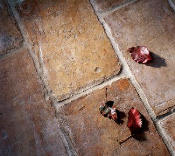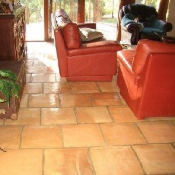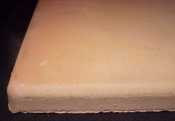Grout. The word alone can bring fear and worry to a homeowner’s mind. What is the best way to clean grout without wearing it away? Does it need to be sealed? If the grout has turned from white to a yellowish color, then a good cleaning is needed. But if the grout is turning black, missing in large areas or the tile is loose, there is a different problem than just dirt.
The solution for cleaning grout is easy, but it requires elbow grease. Never use any abrasives, as they will wear the grout away. The tools needed are: a scrub pad, hot water, Grease Lightning, gloves and safety razors.
Use the safety razor flat against the tile and remove any layers of soap. This is usually found below the soap dish and the bottom three to four layers of tile. Fill a bucket with the hottest water you can stand. Spray a wall with Grease Lightning, put on the gloves and scrub away. Pay special attention to the grout lines and scrub the vertical and horizontal lines.
Once one wall is completed, rinse with hot water and clean the next wall. This should return the grout close to its original color. If there is any missing grout, fill the holes with new grout that is as close as possible to the color of the existing grout. Finally, seal the grout with a sealer found at any hardware store.
Turn a flashlight on and hold it flat against the wall so that the grout lines are clearly illuminated. The tile edges form the vertical and horizontal lines where the grout should be. At the top of the shower wall, you can usually see how the grout completely fills the space between the tiles.
Now bring the flashlight halfway down the wall and see if the grout still fills the gap. Take the flashlight all the way to the bottom of the wall and look at the grout lines. Are they still filled? Do you see black from missing grout or even mold? Don’t be fooled by soap in the grout lines, which can scraped off by lightly scratching it with a knife.
Grout lines should only contain grout. If caulk has been used as a substitute, mold will grow in the grout lines. Caulk should only be used at the joints such as two walls or where the tub and wall meet. Sometimes people use caulk where grout has popped out. If the tile looks like it is popping out or is out of position, it is time to employ your knuckles. If you are wondering if the tile is loose, rap it with your knuckles at the bottom of the wall. This is where the tile usually comes loose. If you hear a rattle, then the tile has pulled away from the backer board, and there is a bigger problem than just missing grout.
If a lot of the grout is missing, a few more steps are needed to bring the grout back to life. A layer of grout must be removed and the walls regrouted. Follow the cleaning steps above, and then figure out the best way to remove that layer of grout. This will be dictated by the width between the tiles.
There are numerous hand tools that do an excellent job, but a preferred tool is the triangular shaped scraper sold in hardware stores. If you are confident with power tools, a rotary tool or vibratory tool does a fine job. It doesn’t really matter because most of the grout has already worn away, and you are just trying to scrape down to a clean layer. If the grout lines were caulked, then after scraping you will have to use a safety blade and maybe snap blade to remove the caulking.
You can now regrout, but a final word of warning – Do not use premixed grout. Use only the dry grout that is mixed with water for long life and quality work. Follow the manufacturer’s direction on mixing and applying the grout. Finally, be sure to seal the grout to help keep it clean.
 So, concentrated that any other similar product gets put to shame. 2 oz makes a gallon ready to use! That is 240 gallons in a pail to destroy grease, dirt and protein based stains. In a regular hydroforce (1:9) add 16 oz and the rest water.
So, concentrated that any other similar product gets put to shame. 2 oz makes a gallon ready to use! That is 240 gallons in a pail to destroy grease, dirt and protein based stains. In a regular hydroforce (1:9) add 16 oz and the rest water.










 Do You Have Dull Concrete Floors and Want Them To Shine?
Do You Have Dull Concrete Floors and Want Them To Shine?
